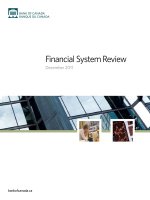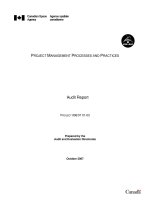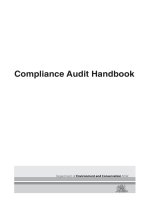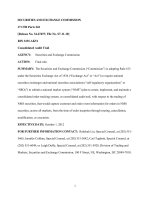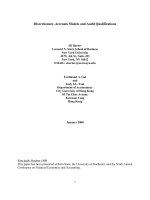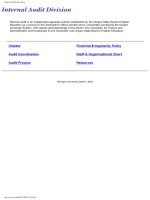Internal Audit Division: OREGON UNIVERSITY SYSTEM INTERNAL AUDIT CHARTER ppt
Bạn đang xem bản rút gọn của tài liệu. Xem và tải ngay bản đầy đủ của tài liệu tại đây (331.87 KB, 57 trang )
Internal Audit Division Home
Internal Audit Division
Internal Audit is an independent appraisal activity established by the Oregon State Board of Higher
Education as a service to the Chancellor's Office and the seven universities comprising the Oregon
University System. IAD reports administratively to the Senior Vice Chancellor for Finance and
Administration and functionally to the Chancellor and Oregon State Board of Higher Education.
Charter Financial Irregularity Policy
Audit Coordination Staff & Organizational Chart
Audit Process Resources
©Oregon University System, 2004
6:35:20 AM
Internal Audit Division Charters
Internal Audit Division
Charters
Internal Audit Charter
Oregon State Board of Higher Education Audit Charter
©Oregon University System, 2004
6:35:23 AM
IAD Internal Audit Charter
Internal Audit Division
Internal Audit Charter
OREGON UNIVERSITY SYSTEM
INTERNAL AUDIT CHARTER
Introduction
Internal auditing is an independent, objective, assurance and consulting activity
designed to add value and improve the organization’s operations. It helps an
organization accomplish its objectives by bringing a systematic, disciplined approach to
evaluate and improve the effectiveness of risk management, control, and governance
processes. The objectives of internal auditing are to assist members of the organization
in the effective discharge of their responsibilities by furnishing them with analyses,
appraisals, recommendations, counsel, and information concerning the activities
reviewed and by promoting effective control at reasonable cost.
Role of the Internal Audit Department
The Oregon State Board of Higher Education and the Chancellor established the Internal
Audit Division and its responsibilities. The responsibilities are defined in this charter,
which is approved by the Oregon State Board of Higher Education. The Director of
Internal Audit reports administratively to the Chief Operations Officer and functionally to
the Chancellor and Finance, Budget, Audit, Personnel, and Real Estate Standing
Committee of the State Board of Higher Education.
Authorization and Responsibilities
Authorization is granted for full and complete access to any of the organization's records
(either manual or electronic), physical properties, and personnel relevant to a audit
engagement. Documents and information given to internal auditors during a periodic
review will be handled in a confidential and prudent manner as required by the
International Institute of Internal Auditors code of ethics.
Internal auditors have no direct responsibility or any authority over any of the activities
or operations that they review. They should not develop and install procedures, prepare
records, or engage in activities, which would normally be reviewed by internal auditors.
Recommendations on standards of control to apply to a specific activity may be included
in the written report of audit findings and opinions, which is given to the operating
management for review and implementation. Copies of final reports will be distributed
to university management and the Chief Operations Officer.
Definition of Audit Scope
The scope of internal auditing encompasses the following activities:
· Review the adequacy and effectiveness of internal control systems
(1 of 3)3/1/2005 6:35:26 AM
IAD Internal Audit Charter
· Review established systems, policies and procedures to ensure the organization is in
compliance with laws and regulations
· Review means of safeguarding assets
· Appraise efficiency and effectiveness with which resources are deployed
· Coordinate audit efforts with those of the organization’s external auditors
· Participate in the design/development of new business and computer systems
· Review the organization’s compliance guidelines for ethical business conduct
· Evaluate plans and actions taken to correct reported conditions
· Provide adequate follow-up to ensure corrective action is taken and evaluate its
effectiveness
· Periodically report audit findings and status of corrective action to the Chancellor
and the Finance, Budget, Audit, Personnel, and Real Estate Standing Committee of the
State Board of Higher Education
· Submit annual audit plan, budget, and status to the Chancellor and the Finance,
Budget, Audit, Personnel, and Real Estate Standing Committee of the State Board of
Higher Education
Reporting Accountabilities
A written report will be prepared and issued by the Director of Internal Audit following
the conclusion of each audit and will be distributed as appropriate.
The manager of the activity or department receiving the internal audit report will
respond within 30 days. This response will indicate what actions were taken or are
planned in regard to the specific findings and recommendations in the internal audit
report. If appropriate, a timetable for the anticipated completion of these actions will be
included.
The Director of Internal Audit will meet with the Chief Operations Officer and the
Chancellor quarterly or more frequently as deemed necessary.
A summary of audit results will be provided to the Chancellor and Finance, Budget,
Audit, Personnel, and Real Estate Standing Committee of the State Board of Higher
Education semi-annually and more frequently as deemed necessary.
Board Approved: September 10, 2004.
Page Top
(2 of 3)3/1/2005 6:35:26 AM
IAD Internal Audit Charter
©Oregon University System, 2004
(3 of 3)3/1/2005 6:35:26 AM
IAD Oregon State Board of Higher Education Charter
Internal Audit Division
Oregon State Board of Higher Education
Charter
OREGON UNIVERSITY SYSTEM
OREGON STATE BOARD OF HIGHER EDUCATION
AUDIT CHARTER
Audit Responsibilities
The Oregon State Board of Higher Education has oversight responsibility to ensure that
Oregon University System (OUS) management is performing their duties of financial
reporting, effective and efficient internal controls, and compliance with laws, regulations,
and ethics. As part of this oversight responsibility, the Oregon State Board of Higher
Education shall have the following responsibilities and powers and shall perform the
following functions as it relates to audits.
External Audit Duties
· The Secretary of State Audits Division shall provide the Oregon State Board of
Higher Education notice of the external auditors selected to complete the annual
financial statement and A-133 audit of the Oregon University System.
· The Oregon State Board of Higher Education shall meet with the external auditors
annually to review the scope and nature of the annual audit, and to review the results of
the auditing engagement.
Internal Audit Duties
· The Oregon State Board of Higher Education shall approve annually the Internal
Audit Division’s audit plans and budget.
· The Oregon State Board of Higher Education shall review at least semi-annually the
results of Internal Audit recommendations and follow-up procedures. More frequent
meetings will be held as deemed necessary.
(1 of 2)3/1/2005 6:35:33 AM
IAD Oregon State Board of Higher Education Charter
· The Oregon State Board of Higher Education shall approve, as recommended by the
Chancellor, the appointment or removal of the Director of Internal Audit Division.
General Duties and Powers
· The Oregon State Board of Higher Education shall review any recommendations the
external auditors or OUS staff may have for improving internal accounting controls,
management systems, or choices of accounting principles.
· Any financial irregularity resulting in losses in excess of $10,000 or involving a
member of senior management shall be brought to the attention of the Chancellor and
the Oregon State Board of Higher Education.
· The Oregon State Board of Higher Education shall devote, as necessary, a portion of
the audit meetings to an executive session at which only the Director of Internal Audit
Division and the external auditors are present with the Board to discuss matters exempt
from public disclosure under Oregon Revised Statute Public Records Policy 192.
· The Oregon State Board of Higher Education shall have and exercise all other
powers, as it shall deem necessary for the performance of its duties.
· The Oregon State Board of Higher Education has delegated these audit duties to the
Finance, Budget, Audit, Personnel, and Real Estate Standing Committee. The Finance,
Budget, Audit, Personnel, and Real Estate Standing Committee shall report the results of
internal and external audit findings to the full Board at least once a year.
Board Approved: September 10, 2004.
Page Top
©Oregon University System, 2004
(2 of 2)3/1/2005 6:35:33 AM
IAD Audit Coordination
Internal Audit Division
Audit Coordination
Coordination with External Auditors
The Internal Audit Division (IAD) coordinates with the external auditors to ensure
efficient and economical utilization of audit resources. IAD meets with the Secretary of
State Audits Division and the external financial auditors twice a year and more
frequently as needed. The goal of the meetings is to discuss staffing changes, audit
plans, risks, and coordination. IAD attends external auditor entrance conferences and
exit conferences.
Page Top
©Oregon University System, 2004
6:35:37 AM
IAD Audit Process
Internal Audit Division
Audit Process
Selection of Audit Area
Planning & Notification
Entrance Conference
Field Work
Communication
Exit Conference
Draft Audit Report & Management Responses
Final Audit Report
Follow-up
Selection of Audit Area
Areas selected for audit are on an audit plan. The plan is based upon input from
university and system administration, State Board of Higher Education, and the Internal
Audit staff.
Factors that are considered in selecting units to be audited include:
● Results of the last audit of the area and length of time since last audit
● The size and complexity of the operation
● Potential risk of financial loss
● Major changes in operation, program, systems, or controls
● Highly regulated operations or operations subject to a high level of public scrutiny
● Degree of manual and automated processing
● Confidence in management
● Sensitivity (image, reputation, political)
● Assets
● Profits
● Sales
● Employee turnover
● Risk of loss
● Other
Planning & Notification
First, you will receive a letter to inform you of an upcoming audit. The auditor will send
you a preliminary checklist. This is a list of documents (e.g. organization charts, financial
statements) that will help the auditor learn about your unit before planning the audit.
During the planning stages, the auditor will also ask you to identify potential audit
objectives that would add value to your organization.
(1 of 3)3/1/2005 6:35:42 AM
IAD Audit Process
Entrance Conference
At the beginning of each audit, a meeting is scheduled with the unit head and other
appropriate personnel to discuss the audit scope and objectives, time schedule, and
audit review process. Any concerns raised by the unit personnel are also discussed.
Field Work
After the entrance conference, the auditor will begin fieldwork. Fieldwork involves
interviewing staff, reviewing policy and procedures, and performing detailed tests.
The emphasis of the evaluation is to determine if there are adequate control systems
and whether the systems are functioning as intended. The controls are measured against
System, State, and Federal policies and procedures, as well as, generally accepted
accounting principles. Areas of deficiencies and potential recommendations are discussed
with the appropriate staff and are documented in the audit work papers. Auditors will
also discuss control strengths identified within your unit.
Communication
Throughout the process, the auditor will keep you informed. You will have an opportunity
to discuss and confirm the potential problems found and possible solutions.
Exit Conference
A meeting is scheduled with the same individuals who attended the entrance conference.
At the exit conference, a rough draft of the audit report is reviewed so that all of the
parties understand the nature of the recommendations and agree upon the possible
solutions to any problem areas. Any misunderstandings or possible misstatements
contained in the report are identified and resolved. Any deficiencies identified during the
audit, which were not significant enough to be included in the audit report, but still
represent a potential risk, are also discussed.
Draft Audit Report & Management Responses
After the exit conference, a draft of the audit report is finalized. The manager of the
activity or department receiving the internal audit report will respond within 30 days.
This response will indicate what actions were taken or are planned in regard to the
specific findings and recommendations in the internal audit report. If appropriate, a
timetable for the anticipated completion of these actions will be included.
Final Audit Report
The unit's responses are added and any noted corrections are made to the audit report.
The final audit report is printed and bound in booklet format by Internal Auditing. The
report is distributed to the appropriate university officials.
(2 of 3)3/1/2005 6:35:42 AM
IAD Audit Process
Follow-up
There will be a follow-up review approximately 6 to 12 months after the audit. The
purpose of the follow-up is to verify that you have implemented the agreed-upon
corrective actions. The auditor will interview staff, perform tests, or review new
procedures. The auditor will issue a follow-up memo indicating whether further actions
are necessary. If further corrective action is required, you will need to identify what
future corrective action is to be taken. Otherwise, you're all done.
Page Top
©Oregon University System, 2004
(3 of 3)3/1/2005 6:35:42 AM
IAD Financial Irregularity Policy
Internal Audit Division
Financial Irregularity Policy
OREGON UNIVERSITY SYSTEM
POLICY ON FINANCIAL IRREGULARITIES
Applicability
All Oregon University System Employees
Policy Statement
The Oregon University System (OUS) is committed to the highest standards
of morality and ethical behavior. All employees of the Oregon University
System shall report known or suspected financial irregularities to their
department manager, who is responsible for forwarding the report to the
institutional designated administrator at the time they become aware of the
incident. The institutional designated administrator must report known or
suspected financial irregularities to the Oregon University System Internal
Audit Division in accordance with institutional policy. All parties involved
must handle the reports with confidentiality and objectivity.
It is important that when an employee makes a good faith report of known
or suspected financial irregularities, this employee feels safe and protected
from retaliation. The Oregon University System shall take steps to protect
the reputation and maintain the confidentiality of the employee that is
reporting the suspected financial irregularity. The Whistleblowers Protection
Law defined in ORS 659.545 protects employees disclosing fraud in good
faith. Persons found to be making frivolous claims under this policy will be
subject to disciplinary action.
Definitions
Financial Irregularities are intentional misstatements or omissions of
information related to financial transactions that are detrimental to the
interests of the campuses or System. These may include violations of
relevant Federal, State, OUS or campus laws, rules, and procedures.
These acts include, but are not limited to embezzlement, fraud, and forgery
or falsification of reports, documents or computer files to misappropriate
assets.
Suspected Financial Irregularity is a reasonable belief or actual knowledge
that a financial irregularity is occurring or has occurred.
Department Manager is the immediate supervisor or individual with
administrative responsibility for the unit where the suspected financial
irregularity is occurring or has occurred.
Institutional Designated Administrator as defined in the OUS institutional
financial irregularity policy and procedure.
(1 of 2)3/1/2005 6:35:54 AM
IAD Financial Irregularity Policy
Related References
Oregon Revised Statutes Chapter 659.505 to 659.545
Oregon Whistleblower Law
OUS Institutional Financial Irregularity Policy and Procedures
Oregon Revised Statutes Chapter 297
Investigating Loss of Public Funds or Property 297.120
Department of Administrative Services Policy Manual
Number 125-7-203
Issuing Division- Risk Management Division
Employee Dishonesty Policy
Individual Policies
CO UO OSU PSU WOU EOU OIT SOU
Page Top
©Oregon University System, 2004
(2 of 2)3/1/2005 6:35:54 AM
IAD Staff
Internal Audit Division
Staff
Internal Audit Division
240 Kerr Administration Bldg (KAd)
P.O. Box 488
Corvallis, OR 97339-0488
(541) 737-2193 Voice
(541) 737-9133 Fax
Kambra Anderson
Office Assistant
(541) 737-2193
Kathy Berg
Audit Supervisor
Certified Public Accountant, Certified Internal Auditor,
Certified Information Systems Auditor
(541) 737-0514
Linda Eki
PSU Senior Auditor
Certified Public Accountant (503) 725-9730
David Riley
Audit Supervisor
(541) 737-0506
Patricia A. Snopkowski
Director
Certified Public Accountant, Certified Internal Auditor (541) 737-0505
Internal Audit Division Organizational Chart
This page was last updated January 18, 2005.
(1 of 2)3/1/2005 6:36:00 AM
IAD Staff
Page Top
©Oregon University System, 2004
(2 of 2)3/1/2005 6:36:00 AM
IAD Resources
Internal Audit Division
Resources
Self-Evaluation Internal Control Tools
Cash & Accounts Receivables
Potential Problems
Departmental Questions
Purchasing & Procurement Card
Potential Problems
Departmental Questions
Fixed Assets & Minor Equipment
Potential Problems
Departmental Questions
Payroll & Human Resources
Potential Problems
Departmental Questions
Environmental Self-Assessment
Environmental Virtual Campus - Massachusetts Institute of Technology
Presentations
Surviving an Audit - (PowerPoint Version)
Surviving an Audit - (PDF Version)
Informational Links
(1 of 2)3/1/2005 6:36:20 AM
IAD Resources
OUS Controller's Division
Eastern Oregon University Business Services Office
Oregon Institute of Technology Business Affairs Office
Oregon State University Business Affairs Office
Portland State University Business Affairs Office
Southern Oregon University Business Services Office
University of Oregon Business Affairs Office
Western Oregon University Business Affairs Office
Oregon Secretary of State Audits Division
Page Top
©Oregon University System, 2004
(2 of 2)3/1/2005 6:36:20 AM
IAD - Cash Receipts & Accounts Receivables Potential Problems
Internal Audit Division
Cash Receipts & Accounts Receivables
Potential Problems - Inadequate Safeguarding of Assets
1. Funds received are not immediately recorded on a mail log, cash receipt slip, cash
register, or electronic receivable system.
2. Checks are not restrictively endorsed "FOR DEPOSIT ONLY" immediately upon
receipt.
3. Custody of funds is not adequately controlled. Fund transfers between receiver,
recorder, verifier, and depositor are not documented.
4. More than one cashier utilizes the same cash drawer or the fund is not balanced
between shifts.
5. Voids, errors, or other corrections are not reviewed and approved by a supervisor.
6. Safe access is available to more than three employees (including supervisors), or
locks and combinations are not changed when staff with access leave.
7. A second employee does not verify funds deposited.
8. Funds collected are not deposited timely.
9. Outstanding receivables are not adequately monitored (aged so that old
receivables are easily identifiable and reviewed by management), and
management does not adequately approve A/R write-offs.
10. Duties of cash collections, asset custody, record keeping or recording,
authorization, and reconciliation are not adequately segregated or monitored.
11. Management reports are too general or excessively detailed, making review
difficult.
12. Account reconciliation is not performed within 30-60 days of period end.
13. A supervisor does not review reconciliation or the review is not documented
(initials and date).
14. Complete listings of accounts receivables are not maintained.
Page Top
©Oregon University System, 2004
6:36:25 AM
IAD - Cash Receipts & Accounts Receivables Departmental Questions
Internal Audit Division
Cash Receipts & Accounts Receivables
Departmental Questions
Answer each question with a "Yes" or "No". "No" responses indicate a potential internal
control weakness. Consult with your Business Affairs office on possible internal control
weaknesses.
1. Do appropriate unit personnel have access and knowledge to all applicable policies
and procedures?
2. Are checks endorsed "FOR DEPOSIT ONLY PAYABLE TO UNIVERSITY" immediately
upon receipt?
3. Are cash registers used? If so:
a. Is cash counted and verified when cashiers receive their cash drawers?
b. Is access limited to one individual per cash drawer during a shift?
c. Are cash register summary tapes reconciled to cash counts at the end of
a shift?
4. Is cash stored in a safe or other secure location and periodically counted by an
independent person to verify completeness?
5. Is access to cash receipts restricted to specific individuals?
6. Does the unit perform periodic, unannounced cash counts? If so:
a. Are all counts documented?
b. Does a supervisor with no custodial responsibilities perform the count?
c. Are variances investigated and reviewed by management?
7. Are cash receipts deposited in a timely manner?
8. Does your department prohibit the commingling of cash receipts with petty cash or
using cash receipts to replenish a petty cash fund?
9. Are large sums of cash transported to the central business office via AMSA-
armored car service?
10. Are all cash receipts recorded in a log, journal, or other system?
11. Are pre-numbered receipts or acknowledgments provided to customers or other
senders of cash?
12. Are cash receipt records reconciled to deposit slips and university statements? Are
these records reviewed by management for completeness and timeliness of the
deposit?
13. Are cash handling, recording, and reconciliation to statements or deposit slips
performed by different personnel?
14. Does a second party verify the timeliness and completeness of cash deposits?
15. Does your department maintain a complete record of accounts receivables?
(1 of 2)3/1/2005 6:36:35 AM
IAD - Cash Receipts & Accounts Receivables Departmental Questions
16. Is the recording of additions and reductions to accounts receivable records
segregated from the person posting the deposits?
17. Are accounts receivable write-offs verified by someone other than the recorder of
A/R or the receiver of cash?
Page Top
©Oregon University System, 2004
(2 of 2)3/1/2005 6:36:35 AM
IAD - Purchasing & Procurement Cards Potential Problems
Internal Audit Division
Purchasing & Procurement Cards
Potential Problems - Unauthorized, Unsupported, or Fraudulent
Transactions
1. Expenditures are not approved in advance as required by policy (travel).
2. Receipt of goods and services is not documented.
3. Expenditures are not processed timely.
4. Expenditures are not within grant guidelines or are processed outside grant terms.
5. Blanket purchase order limits are exceeded.
6. Expenditures are excessive, unauthorized, or unallowable according to policy.
7. Support documentation for expenditures is not maintained.
8. Duties of authorization to purchase, process, and maintain expenditures records,
receipt of goods and services, and reconciliation are not segregated.
9. Lack of justification for convention/conference or out-of-state travel.
10. Inadequate support for expenditures (airfare, hotel, etc).
11. Duplicate reimbursement for meals that are provided by conference.
12. Inadequate justification for non-contract rental cars or airfare.
13. Incorrectly computed per diem (especially related to meals included in seminar
fees).
14. Inadequately documented trip purpose.
15. Management reports are too general or excessively detailed, making review
difficult. Department may use a shadow system and a reconciliation to Banner is
not performed.
16. Reports are not prepared timely or do not contain outstanding revenue or
expenditures yet to be processed by centralized units.
17. Account reconciliation is not performed within 30-60 days of period end.
18. Account reconciliation does not include balances for both record sources and a list
of outstanding items.
19. A supervisor does not review reconciliation of financial transactions or the review is
not documented (initials and date).
(1 of 2)3/1/2005 6:36:41 AM
IAD - Purchasing & Procurement Cards Potential Problems
Page Top
©Oregon University System, 2004
(2 of 2)3/1/2005 6:36:41 AM
IAD - Purchasing & Procurement Cards Departmental Questions
Internal Audit Division
Purchasing & Procurement Cards
Departmental Questions
Answer each question with a "Yes" or "No". "No" responses indicate a potential internal
control weakness. Consult with your Business Affairs office on possible control
weaknesses.
1. Do the appropriate unit personnel have access to and knowledge of the applicable
policies?
2. Do you periodically review the list of your unit’s authorized signers and receivers to
ensure it is appropriate and adequate?
3. Do you ensure that a purchase order was properly completed, if required?
4. If a transaction warrants a formal contract or agreement instead of or in addition
to the purchase order, do you ensure it is completed?
5. Are you aware when competitive bidding is required? If yes, do you follow these
procedures for all purchases of goods and services?
6. If a transaction relates to personnel services, are steps taken to determine if the
service provider is an independent contractor?
7. Is a sole source justification completed when solicitation of competitive bids is not
justified?
8. Are you aware of and do you take measures to ensure requisitions are not split to
circumvent the established levels for bidding?
9. Do you review and respond to problem documents forwarded by purchasing in a
timely manner?
10. Do unit representatives sign for receipt of goods and services?
11. Do you ensure that an original invoice supports the request for payment and that
the invoice is accurate?
12. Are purchase initiations, receipts of goods, and payment authorizations performed
by the same individual?
13. Do managers review Banner transaction statements for the department on a
monthly basis for appropriateness of purchases?
14. Do unit personnel know they are not to accept gifts from vendors? Do employees
turn down gifts offered by vendors?
15. Are you using standard contracts authorized by the purchasing department?
16. Do all cardholders undergo training prior to receiving and using cards?
(1 of 2)3/1/2005 6:36:46 AM
IAD - Purchasing & Procurement Cards Departmental Questions
17. Is a log maintained for all procurement card purchases?
18. Is the log reconciled to the monthly statements for accuracy of charges?
19. Do receipts support all charges?
20. Does someone other than the card user and custodian (with departmental
oversight and program knowledge) review the records on monthly basis to ensure
the appropriateness of the charges?
21. Do all charges to the card adhere to restrictions outlined in the procurement card
policy?
22. Is the procurement card agreement that lists all authorized users current?
Page Top
©Oregon University System, 2004
(2 of 2)3/1/2005 6:36:46 AM
IAD - Fixed Assets & Minor Equipment Potential Problems
Internal Audit Division
Fixed Assets & Minor Equipment
Potential Problems - Inadequate Safeguarding of Assets
1. Attractive, easily moved inventory items are not adequately secured.
2. Inventory locations are not accurate.
3. Obsolete inventory is not transferred to surplus property.
4. Lost, stolen, or un-locatable inventory is not reported timely.
5. Disassembled inventory is not approved in advance or removed from inventory.
6. A loan agreement is not on file for loaned property. Example of loaned property –
industry lends equipment for university use, but maintains ownership.
7. A form is not in place to document off-campus equipment use by department
personnel.
Page Top
©Oregon University System, 2004
6:36:49 AM
